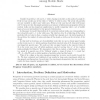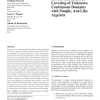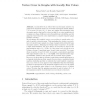16 search results - page 2 / 4 » Tight Bounds for the Cover Time of Multiple Random Walks |
ADHOCNOW
2004
Springer
13 years 10 months ago
2004
Springer
Consider k particles, 1 red and k −1 white, chasing each other on the nodes of a graph G. If the red one catches one of the white, it “infects” it with its color. The newly ...
EJC
2007
13 years 5 months ago
2007
Jim Propp’s P-machine, also known as the ‘rotor router model’ is a simple deterministic process that simulates a random walk on a graph. Instead of distributing chips to ran...
SPAA
1993
ACM
13 years 9 months ago
1993
ACM
We give tight bounds on the parallel complexity of some problems involving random graphs. Speci cally, we show that a Hamiltonian cycle, a breadth rst spanning tree, and a maximal...
IJRR
2008
13 years 5 months ago
2008
We propose a new `Mark-Ant-Walk' algorithm for robust and efficient covering of continuous domains by ant-like robots with very limited capabilities. The robots can mark plac...
ICALP
2011
Springer
12 years 8 months ago
2011
Springer
In [13], Erd˝os et al. defined the local chromatic number of a graph as the minimum number of colors that must appear within distance 1 of a vertex. For any ∆ ≥ 2, there are ...



